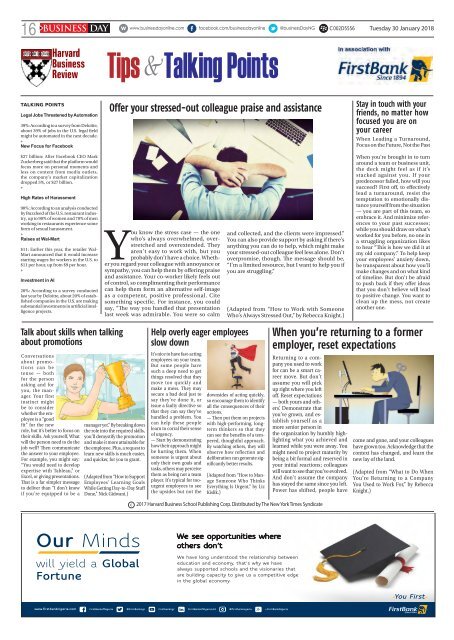BusinessDay 30 Jan 2018
You also want an ePaper? Increase the reach of your titles
YUMPU automatically turns print PDFs into web optimized ePapers that Google loves.
16 BUSINESS DAY C002D5556 Tuesday <strong>30</strong> <strong>Jan</strong>uary <strong>2018</strong><br />
Harvard<br />
Business<br />
Review<br />
Tips<br />
&<br />
Talking Points<br />
TALKING POINTS<br />
Legal Jobs Threatened by Automation<br />
39%: According to a survey from Deloitte,<br />
about 39% of jobs in the U.S. legal field<br />
might be automated in the next decade.<br />
+<br />
New Focus for Facebook<br />
Offer your stressed-out colleague praise and assistance<br />
Stay in touch with your<br />
friends, no matter how<br />
focused you are on<br />
your career<br />
When Leading a Turnaround,<br />
Focus on the Future, Not the Past<br />
$27 billion: After Facebook CEO Mark<br />
Zuckerberg said that the platform would<br />
focus more on personal moments and<br />
less on content from media outlets,<br />
the company’s market capitalization<br />
dropped 5%, or $27 billion.<br />
+<br />
High Rates of Harassment<br />
90%: According to an analysis conducted<br />
by Buzzfeed of the U.S. restaurant industry,<br />
up to 90% of women and 70% of men<br />
working in restaurants experience some<br />
form of sexual harassment.<br />
+<br />
Raises at Wal-Mart<br />
$11: Earlier this year, the retailer Wal-<br />
Mart announced that it would increase<br />
starting wages for workers in the U.S. to<br />
$11 per hour, up from $9 per hour.<br />
+<br />
Investment in AI<br />
20%: According to a survey conducted<br />
last year by Deloitte, about 20% of established<br />
companies in the U.S. are making<br />
substantial investments in artificial intelligence<br />
projects.<br />
Talk about skills when talking<br />
about promotions<br />
Conversations<br />
about promotions<br />
can be<br />
tense — both<br />
for the person<br />
asking and for<br />
you, the manager.<br />
Your first<br />
instinct might<br />
be to consider<br />
whether the employee<br />
is a “good<br />
fit” for the new<br />
role, but it’s better to focus on<br />
their skills. Ask yourself, What<br />
will the person need to do the<br />
job well? Then communicate<br />
the answer to your employee.<br />
For example, you might say:<br />
“You would need to develop<br />
expertise with Tableau,” or<br />
Excel, or giving presentations.<br />
That is a far simpler message<br />
to deliver than “I don’t know<br />
if you’re equipped to be a<br />
You know the stress case — the one<br />
who’s always overwhelmed, overstretched<br />
and overextended. They<br />
aren’t easy to work with, but you<br />
probably don’t have a choice. Whether<br />
you regard your colleague with annoyance or<br />
sympathy, you can help them by offering praise<br />
and assistance. Your co-worker likely feels out<br />
of control, so complimenting their performance<br />
can help them form an alternative self-image<br />
as a competent, positive professional. Cite<br />
something specific. For instance, you could<br />
say, “The way you handled that presentation<br />
last week was admirable. You were so calm<br />
manager yet.” By breaking down<br />
the role into the required skills,<br />
you’ll demystify the promotion<br />
and make it more attainable for<br />
the employee. Plus, a request to<br />
learn new skills is much easier,<br />
and quicker, for you to grant.<br />
(Adapted from “How to Support<br />
Employees’ Learning Goals<br />
While Getting Day-to-Day Stuff<br />
Done,” Nick Gidwani.)<br />
c<br />
Help overly eager employees<br />
slow down<br />
It’s nice to have fast-acting<br />
employees on your team.<br />
But some people have<br />
such a deep need to get<br />
things resolved that they<br />
move too quickly and<br />
make a mess. They may<br />
secure a bad deal just to<br />
say they’ve done it, or<br />
issue a faulty directive so<br />
that they can say they’ve<br />
handled a problem. You<br />
can help these people<br />
learn to corral their sense<br />
of urgency.<br />
— Start by demonstrating<br />
how their approach might<br />
be hurting them. When<br />
someone is urgent about<br />
only their own goals and<br />
tasks, others may perceive<br />
them as being not a team<br />
player. It’s typical for toourgent<br />
employees to see<br />
the upsides but not the<br />
and collected, and the clients were impressed.”<br />
You can also provide support by asking if there’s<br />
anything you can do to help, which might make<br />
your stressed-out colleague feel less alone. Don’t<br />
overpromise, though. The message should be,<br />
“I’m a limited resource, but I want to help you if<br />
you are struggling.”<br />
(Adapted from “How to Work with Someone<br />
Who’s Always Stressed Out,” by Rebecca Knight.)<br />
downsides of acting quickly,<br />
so encourage them to identify<br />
all the consequences of their<br />
actions.<br />
— Then put them on projects<br />
with high-performing, longterm<br />
thinkers so that they<br />
can see the benefits of a tempered,<br />
thoughtful approach.<br />
By watching others, they will<br />
observe how reflection and<br />
deliberation can generate significantly<br />
better results.<br />
(Adapted from “How to Manage<br />
Someone Who Thinks<br />
Everything Is Urgent,” by Liz<br />
Kislik.)<br />
2017 Harvard Business School Publishing Corp. Distributed by The New York Times Syndicate<br />
When you’re brought in to turn<br />
around a team or business unit,<br />
the deck might feel as if it’s<br />
stacked against you. If your<br />
predecessor failed, how will you<br />
succeed? First off, to effectively<br />
lead a turnaround, resist the<br />
temptation to emotionally distance<br />
yourself from the situation<br />
— you are part of this team, so<br />
embrace it. And minimize references<br />
to your past successes;<br />
while you should draw on what’s<br />
worked for you before, no one in<br />
a struggling organization likes<br />
to hear “This is how we did it at<br />
my old company.” To help keep<br />
your employees’ anxiety down,<br />
be transparent about how you’ll<br />
make changes and on what kind<br />
of timeline. But don’t be afraid<br />
to push back if they offer ideas<br />
that you don’t believe will lead<br />
to positive change. You want to<br />
clean up the mess, not create<br />
another one.<br />
When you’re returning to a former<br />
employer, reset expectations<br />
Returning to a company<br />
you used to work<br />
for can be a smart career<br />
move. But don’t<br />
assume you will pick<br />
up right where you left<br />
off. Reset expectations<br />
— both yours and others’.<br />
Demonstrate that<br />
you’ve grown, and establish<br />
yourself as a<br />
more senior person in<br />
the organization by humbly highlighting<br />
what you achieved and<br />
learned while you were away. You<br />
might need to project maturity by<br />
being a bit formal and reserved in<br />
your initial reactions; colleagues<br />
will want to see that you’ve evolved.<br />
And don’t assume the company<br />
has stayed the same since you left.<br />
Power has shifted, people have<br />
come and gone, and your colleagues<br />
have grown too. Acknowledge that the<br />
context has changed, and learn the<br />
new lay of the land.<br />
(Adapted from “What to Do When<br />
You’re Returning to a Company<br />
You Used to Work For,” by Rebecca<br />
Knight.)


















